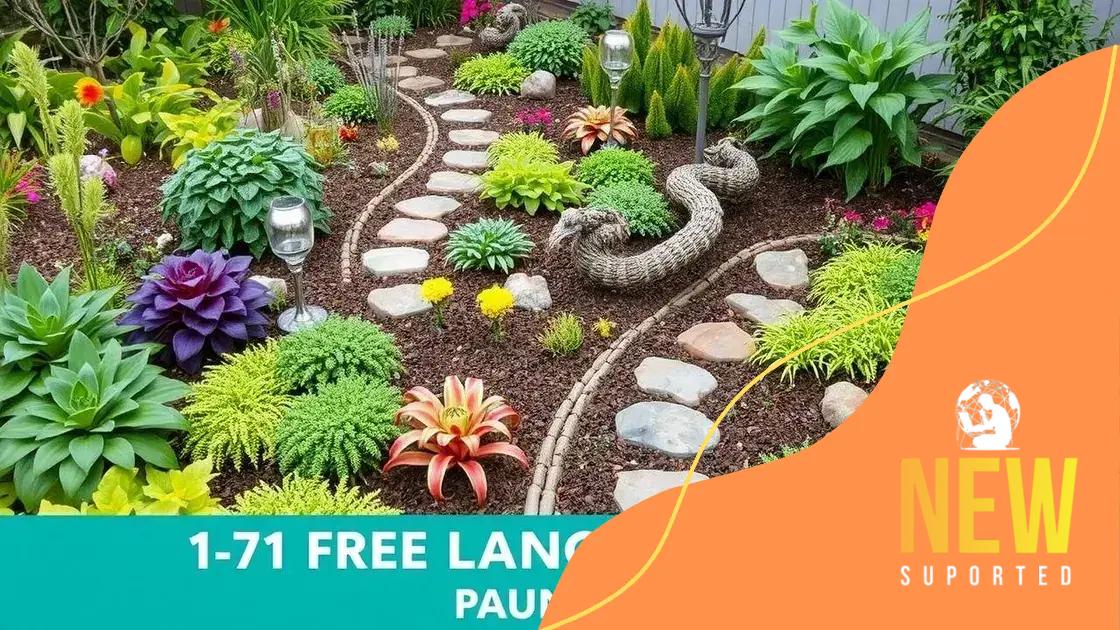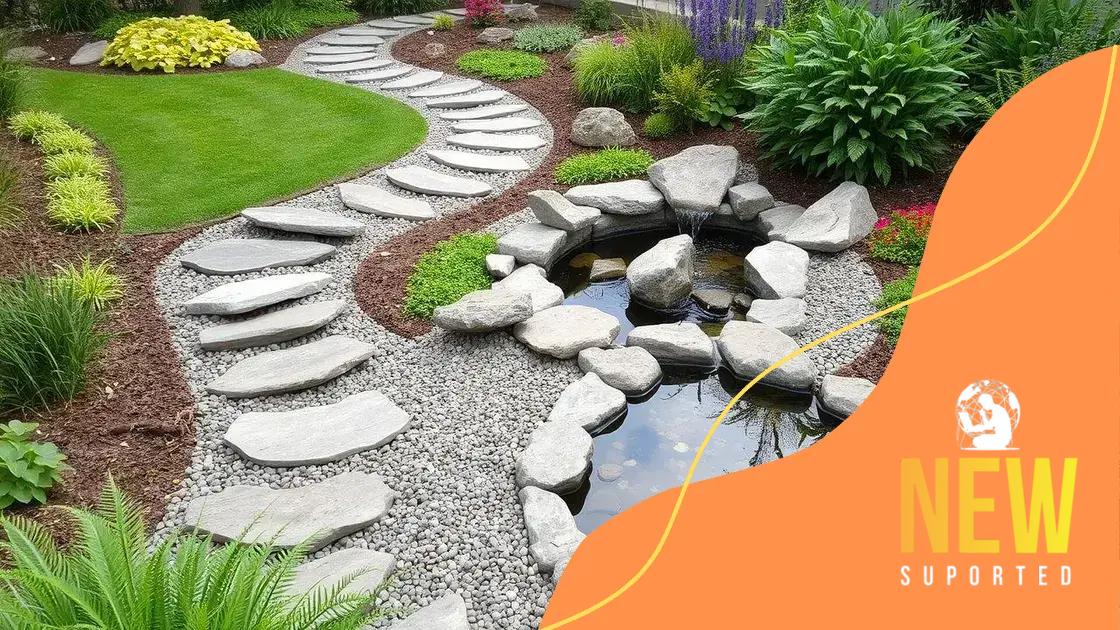Transforming your garden with creative landscaping ideas

Transforming your garden with creative landscaping ideas involves understanding principles like balance, selecting the right plants, incorporating paths and water features, and preparing for seasonal changes to ensure a vibrant outdoor space year-round.
Transforming your garden with creative landscaping ideas can truly enhance the overall appeal of your outdoor space. Have you ever thought about how a few well-placed plants and features can completely change a yard? Let’s dive into some exciting concepts that can bring your garden to life!
Understanding the principles of landscaping
Understanding the principles of landscaping is essential for creating a garden that is both beautiful and functional. These principles guide you in organizing your outdoor space effectively.
Start by considering the overall layout. Think about how you want to use your garden. Are you looking for a serene space to relax, or a vibrant area for entertaining? Knowing the purpose helps set the foundation.
Key Principles to Consider
When designing your garden, there are several important principles to keep in mind:
- Balance: Achieving visual balance is crucial. Consider symmetry in your plant arrangements.
- Proportion: Plants should be chosen based on size and shape that complements your space.
- Focal Points: Add features that draw the eye, like a birdbath or a unique sculpture.
Additionally, think about line in your landscaping. Lines direct the viewer’s gaze and can create movement within your garden. Curved paths can soften the harshness of angles, while straight lines can create a more formal look.
Always keep color in mind as well. Different colors evoke various emotions and can enhance the garden’s overall atmosphere. For example, warm colors such as red and yellow energize, while cool colors like blue and green promote relaxation.
Textures and Layers
Using layers adds depth to your garden. Mix different plant heights and textures to create a visually engaging landscape. Consider combining broad-leaved plants with fine-textured ones to contrast effectively. The right combination promotes visual interest throughout various seasons.
Incorporating outdoor structures also plays a role. Decks, pergolas, or garden walls can provide additional structure and support the overall design. Always strive for harmony and purpose in your choices to transform your yard into a stunning landscape.
Choosing the right plants for your space
Choosing the right plants for your space is crucial for creating a vibrant and healthy garden. The type of plants you select can greatly affect the overall look and feel of your outdoor environment.
First, assess your garden’s conditions. Take note of the sunlight, soil quality, and moisture levels. Different plants thrive in different environments, so understanding these factors will help you make informed choices.
Consider the Plant Types
There are several categories of plants to consider:
- Perennials: These plants come back year after year, providing lasting beauty.
- Annuals: These are great for adding seasonal color, as they complete their life cycle in one growing season.
- Shrubs and Trees: Incorporating these can add structure and height to your garden.
In addition to types, think about the size and shape of the plants. Large plants can act as central features, while smaller plants work well as borders or fillers. This layering effect enhances visual interest.
Another important factor is color. Choose colors that complement each other and fit the mood you want to create. Bright, bold colors can energize a space, while softer tones provide tranquility.
Maintenance Needs
Consider the maintenance requirements of the plants. Some plants may require more care, such as frequent watering and pruning. Others may be more resilient and thrive with minimal attention. Think about how much time you can commit to their care.
Lastly, incorporate native plants into your garden. Native plants are adapted to the local climate and soil, making them easier to grow and maintain. They also support local wildlife, creating a harmonious ecosystem. By carefully selecting the right plants, you can transform your garden into a thriving oasis that suits your style and needs.
Incorporating features like paths and water elements

Incorporating features like paths and water elements can significantly enhance the beauty and functionality of your garden. These additions create a sense of structure and movement, guiding visitors through your outdoor space.
Paths are essential as they provide direction and accessibility. Choose materials that complement your garden’s style. For example, stepping stones can offer a natural look, while gravel paths add a rustic touch. Always consider the width of the path to ensure it feels inviting and usable.
Enhancing Your Garden with Paths
When designing your paths, keep these tips in mind:
- Curvature: Gentle curves in your path can create visual interest and encourage exploration.
- Materials: Use materials like flagstone, pavers, or bricks for durability and aesthetic appeal.
- Border Plants: Adding plants along the edges softens the look and integrates the path into the landscape.
Water elements also play a crucial role in landscaping. They provide soothing sounds and attract wildlife, creating a more dynamic environment. Simple water features, such as birdbaths or small fountains, can add charm without overwhelming the space.
Types of Water Features
Explore different types of water features to find what suits your garden best:
- Ponds: Create a tranquil setting. Ponds can support fish and aquatic plants.
- Streams: Add movement by incorporating a small stream or creek bed.
- Waterfalls: These can provide a focal point and interesting sounds, enhancing relaxation.
Combining paths with water elements creates harmony in your garden. These features not only serve practical purposes but also enhance the aesthetic appeal. By carefully planning these components, you can transform your outdoor area into a peaceful retreat where nature thrives.
Creative ideas for small and large gardens
Creative ideas for small and large gardens can transform any outdoor space into a stunning oasis. Whether you have a compact balcony or a sprawling backyard, there are endless possibilities to enhance your garden’s appeal.
For small gardens, it is essential to maximize every inch. Consider using vertical gardening techniques. Hanging planters and wall-mounted pots can create beautiful displays without taking up valuable ground space. You can also use trellises to grow climbing plants, adding height and interest.
Maximizing Small Spaces
Here are some clever ideas to make the most of your small garden:
- Multi-Functional Furniture: Use benches or tables with storage to keep your area organized.
- Layered Planting: Plant taller plants at the back and smaller ones in front to create depth.
- Mirrors: Installation of mirrors can give an illusion of more space and reflect light.
Large gardens offer vast opportunities for creativity. You can create themed areas such as a Japanese Zen garden, a vegetable patch, or a butterfly sanctuary. Use pathways to connect different areas and invite exploration and discovery within the space.
Creating Zones in Large Gardens
Dividing your large garden into distinct zones can enhance its versatility. Consider these suggestions:
- Seating Areas: Create cozy nooks with comfortable seating for relaxation.
- Water Features: Ponds or fountains can become central elements, drawing attention.
- Garden Art: Incorporate sculptures or decorative pots to add personality.
Whichever size your garden is, remember to incorporate color and texture to create a lively atmosphere. Use annuals for bright pops of color and perennials for lasting beauty. By implementing these creative ideas, you can design a garden that reflects your personality and lifestyle.
Seasonal tips for maintaining your garden
Seasonal tips for maintaining your garden are essential for ensuring a thriving and beautiful outdoor space throughout the year. Each season brings unique challenges and opportunities that can enhance the health of your plants.
During spring, focus on preparation. This is the time to clean up your garden, remove debris, and get rid of weeds. Once the soil is ready, consider adding compost to enrich it. Plan your planting schedule based on your climate and the types of plants you want to grow.
Spring Maintenance Tips
Some essential tasks include:
- Test Soil: Check pH levels to understand nutrient needs.
- Plant Selection: Choose hearty plants that thrive in your region.
- Watering: Establish a regular watering schedule as the weather warms up.
As summer approaches, pay attention to watering and pest control. Depending on your garden’s layout, you might need to increase watering, especially for new plants. Use mulch around plant bases to maintain moisture and minimize weeds.
Summer Garden Care
Key actions during summer include:
- Pruning: Trim dead or overgrown branches to encourage growth.
- Fertilizing: Apply liquid fertilizers to nourish your plants.
- Watch for Pests: Regularly inspect plants for signs of pests and take action if necessary.
As fall arrives, it’s time to prepare for winter. Start by harvesting any remaining produce and cleaning up fallen leaves. Protect your plants by covering them with mulch or using protective cloths for delicate varieties.
Preparing for Winter
Here are some steps to ensure your garden survives the cold:
- Wrap Trees: Protect young trees with burlap or tree wraps.
- Plant Bulbs: Consider planting spring bulbs in the fall for beautiful blooms.
- Garden Tools: Clean and store your gardening tools to keep them in top condition.
Finally, in winter, maintain a watchful eye on evergreens and check for snow build-up. Clear paths and ensure that any protective coverings are secure. By following these seasonal tips, you’ll keep your garden healthy and vibrant throughout the year.
FAQ – Frequently Asked Questions About Maintaining Your Garden
What should I do in spring to prepare my garden?
In spring, focus on cleaning up your garden, removing debris, and adding compost to enrich the soil for planting.
How can I effectively water my garden in summer?
During summer, establish a regular watering schedule and consider using mulch to retain moisture around plants.
What tasks should I prioritize in fall for my garden?
In fall, harvest remaining produce, clean up fallen leaves, and protect plants with mulch or covers to prepare for winter.
What are some winter maintenance tips for my garden?
In winter, check evergreens for snow build-up, ensure protective coverings are secure, and clean and store your gardening tools.






